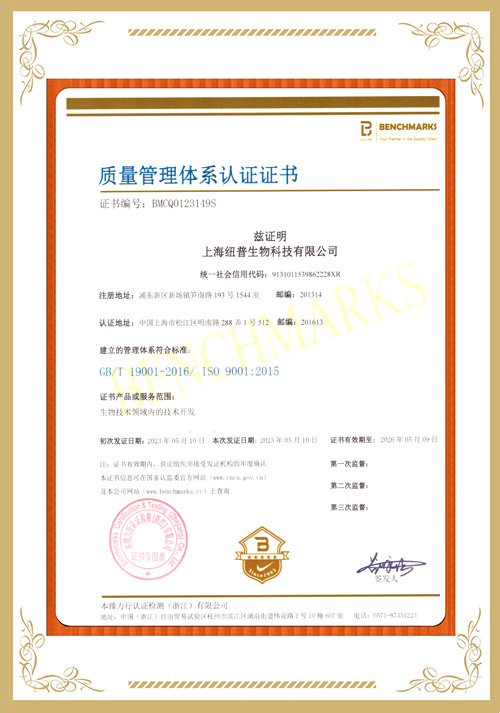我们所展示的质粒图谱主要是从文献和开放数据库中收集而来,主要是为了方便研究工作,其中一小部分质粒进行了质量控制,可供科学家使用。
所有的产品都严格仅供科学研究使用,不能应用于临床试验,包括人体摄入、注射或外用的药理学用途。
确保质粒的关键元件正确,但是我们并不能保证实验结果。页面展示的图谱序列为理论序列,可能与测序结果不一致,请自行比对后确定是否满足要求。(如果测过序,本页面一般会提供下载)
开放数据库中的大多数载体序列都没有被完全测序。如果实际序列与参考序列的相似度超过99%,则将其视为正确。
由于科学研究是在探索未知,具有很大的不确定性,在任何情况下,我们都不承担超出质粒本身的额外经济损失或责任。
pEYFP-Mito encodes a fusion of EYFP and the mitochondrial targeting sequence from subunit VIII of human cytochrome c oxidase (1, 2). The EYFP gene (enhanced yellow fluorescent protein) contains four amino acid substitutions previously published as GFP-10C (3), which shift the emission of the chromophore from green to yellow-green. The fluorescence excitation maximum of EYFP is 513 nm, and the emission spectrum has a peak at 527 nm. In addition to the four chromophore mutations, the coding sequence of the EYFP gene contains more than 190 silent base changes corresponding to human codon-usage preferences (4), which increase the translational efficiency of the EYFP transcript.SV40 polyadenylation signals downstream of the EYFP-Mito fusion direct proper processing of the 3' end of the EYFP-Mito mRNA. The vector backbone also contains an SV40 origin for replication in any mammalian cell line that expresses the SV40 T-antigen. A neomycin resistance cassette (Neo r ), consisting of the SV40 early promoter, the neomycin/kanamycin resistance gene of Tn5, and polyadenylation signals from the herpes simplex virus thymidine kinase (HSV-TK) gene, allow stably transfected eukaryotic cells to be selected using G418. A bacterial promoter upstream of this cassette drives expression of the gene encoding kanamycin resistance in E. coli . The pEYFP-Mito backbone also provides a pUC origin of replication for propagation in E. coli and an f1 origin for single-stranded DNA production.The pEYFP-Mito Vector is designed to be used for the fluorescent labeling of mitochondria (5). Fluorescence can be observed in living or fixed cells by microscopy, fluorometry, or flow cytometry. pEYFP-Mito can be transfected into mammalian cells using any standard transfection method. If required, stable transformants can be selected using G418 (6).
- 载体名称:
- pEYFP-Mito
- 载体抗性:
- Kanamycin
- 载体长度:
- 4759 bp
- 载体类型:
- Fluorescent Protein Reporter Vectors
- 复制子:
- ori
- 筛选标记:
- Neomycin
- 启动子:
- CMV
- 克隆方法:
- Enzyme digestion and ligation
- 载体标签:
- EYFP
- 感受态:
- stbl3
- 培养温度:
- 37℃
pEYFP-Mito 载体图谱
质粒操作方法
1. 发货形式:质粒干粉(常温运输,存于-20度,请务必先转化提质粒后使用)
2. 收到质粒干粉后请先5000rpm离心1min,再加入20μl ddH2O溶解质粒;(质粒复测的浓度有时候与标称值差距较大,这可能是因为冻干质粒在管中的位置、复溶效率、测量偏差以及管壁的吸附导致,因此建议先转化提质粒后再使用)
3. 取1支100μl 感受态于冰上解冻10min,加入2μl质粒,再冰浴30min后,42℃热激60s,不要搅动,再冰浴2min;
4. 加入900μl无抗的LB液体培养基,180rpm震荡37℃培养45min (30℃培养1-1.5小时);
5. 6000rpm离心5min,仅留100μl上清液重悬细菌沉淀,并涂布至目标质粒抗性的LB平板上;
6. 将平板倒置37℃培养14h,如果要求是30℃则培养20h; (菌落过多则将质粒稀释后再转化;没有菌落则加入10μl质粒转化;建议不要直接转表达感受态, 要先转克隆感受态,重提质粒后再导入表达感受态);
7. 挑取单菌落至LB液体培养基中,加入对应抗生素,220rpm震荡培养14h,根据实验需要和质粒提取试剂盒说明书提取质粒。
pEYFP-Mito 载体序列
LOCUS 40924_18956 4759 bp DNA circular SYN 13-JAN-2022
DEFINITION synthetic circular DNA.
ACCESSION .
VERSION .
KEYWORDS .
SOURCE synthetic DNA construct
ORGANISM synthetic DNA construct
REFERENCE 1 (bases 1 to 4759)
TITLE Direct Submission
REFERENCE 2 (bases 1 to 4759)
AUTHORS .
TITLE Direct Submission
COMMENT SGRef: number: 1; type: "Journal Article"
FEATURES Location/Qualifiers
source 1..4759
/mol_type="other DNA"
/organism="synthetic DNA construct"
enhancer 61..364
/label=CMV enhancer
/note="human cytomegalovirus immediate early enhancer"
promoter 365..568
/label=CMV promoter
/note="human cytomegalovirus (CMV) immediate early
promoter"
CDS 705..1421
/codon_start=1
/label=EYFP
/note="enhanced YFP"
/translation="MVSKGEELFTGVVPILVELDGDVNGHKFSVSGEGEGDATYGKLTL
KFICTTGKLPVPWPTLVTTFGYGLQCFARYPDHMKQHDFFKSAMPEGYVQERTIFFKDD
GNYKTRAEVKFEGDTLVNRIELKGIDFKEDGNILGHKLEYNYNSHNVYIMADKQKNGIK
VNFKIRHNIEDGSVQLADHYQQNTPIGDGPVLLPDNHYLSYQSALSKDPNEKRDHMVLL
EFVTAAGITLGMDELYK"
polyA_signal 1547..1668
/label=SV40 poly(A) signal
/note="SV40 polyadenylation signal"
rep_origin complement(1675..2130)
/direction=LEFT
/label=f1 ori
/note="f1 bacteriophage origin of replication; arrow
indicates direction of (+) strand synthesis"
promoter 2157..2261
/label=AmpR promoter
promoter 2263..2620
/label=SV40 promoter
/note="SV40 enhancer and early promoter"
CDS 2655..3446
/codon_start=1
/label=NeoR/KanR
/note="aminoglycoside phosphotransferase"
/translation="MIEQDGLHAGSPAAWVERLFGYDWAQQTIGCSDAAVFRLSAQGRP
VLFVKTDLSGALNELQDEAARLSWLATTGVPCAAVLDVVTEAGRDWLLLGEVPGQDLLS
SHLAPAEKVSIMADAMRRLHTLDPATCPFDHQAKHRIERARTRMEAGLVDQDDLDEEHQ
GLAPAELFARLKASMPDGEDLVVTHGDACLPNIMVENGRFSGFIDCGRLGVADRYQDIA
LATRDIAEELGGEWADRFLVLYGIAAPDSQRIAFYRLLDEFF"
polyA_signal 3681..3728
/label=HSV TK poly(A) signal
/note="herpes simplex virus thymidine kinase
polyadenylation signal (Cole and Stacy, 1985)"
rep_origin 4057..4645
/direction=RIGHT
/label=ori
/note="high-copy-number ColE1/pMB1/pBR322/pUC origin of
replication"

